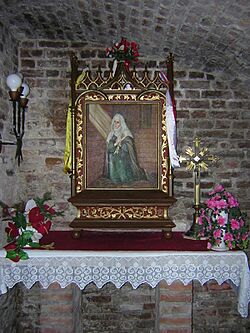Dorothea of Montau facts for kids
Quick facts for kids SaintDorothea of Montau |
|
|---|---|

Cell of Dorothea of Montau in Kwidzyn, Poland
|
|
| Anchoress, Mystic, Virgin, and Visionary | |
| Born | 6 February 1347 Groß Montau, Prussia |
| Died | 25 June 1394 Marienwerder, Prussia |
| Venerated in | Roman Catholic Church |
| Canonized | 9 July 1976, Apostolic Palace, Vatican City by Pope Paul VI |
| Feast | 25 June 30 October |
| Patronage | formerly Prussia, Monastic state of the Teutonic Knights, brides, widows, parents of large families |
Dorothea of Montau (born February 6, 1347 – died June 25, 1394) was a special kind of holy woman from the 14th century. She was known as an anchoress, which means she lived a life of prayer alone in a small room attached to a church. She also had many spiritual visions. After being honored for hundreds of years in Central Europe, she was officially made a saint in 1976.
Contents
Her Life Story
Dorothea was born in a place called Groß Montau, which is now Mątowy Wielkie, Poland. Her father, Willem Swarte, was a rich farmer from Holland.
Early Life and Marriage
When Dorothea was 17, she married a swordsmith named Adalbrecht from Danzig (now Gdańsk, Poland). He was in his 40s and often grumpy. Soon after they married, Dorothea started having spiritual visions. Her husband didn't understand her special experiences and was not always kind to her.
However, Dorothea's gentle and humble nature helped him change. They both became more spiritual and went on long trips to holy places. These trips included Cologne, Aachen, and Einsiedeln Abbey in Switzerland.
Family and Loss
While Dorothea was on a pilgrimage to Rome (with her husband's permission), he passed away around 1389 or 1390. Dorothea and Adalbrecht had nine children. Sadly, eight of them died, some as babies and others during a big sickness called the plague in 1383. Their only surviving daughter, Gertrud, became a Benedictine nun.
Becoming an Anchoress
In the summer of 1391, Dorothea moved to Marienwerder (now Kwidzyn, Poland). On May 2, 1393, she received permission to become an anchoress. She set up a small room, called a cell, against the wall of the cathedral. She lived there for the rest of her life, dedicating herself to prayer and a very simple, strict way of living.
Visions and Writings
Many people came to Dorothea for advice and comfort. She continued to have visions and special messages from God. Her spiritual guide, a smart church leader named Johannes of Marienwerder, wrote down her messages. He wrote a long book about her life in Latin and a shorter one in German.
Dorothea passed away in Marienwerder in 1394. She deeply loved the story of Jesus' suffering and the Eucharist (Holy Communion). It is also said that she had stigmata, which are marks on the body like the wounds of Jesus. Some scholars have noted that her life was similar to another holy woman from Prussia, Saint Jutta of Kulmsee.
Honoring Saint Dorothea
People started honoring Dorothea right after she died. She was seen as a protector of the land ruled by the Teutonic Knights (which was East Prussia) and a special saint for that region.
Path to Sainthood
In 1405, many people (257 witnesses!) shared stories about her good deeds and miracles. The official process to make her a saint was started but then stopped. It didn't begin again until 1955. Finally, Pope Paul VI officially made her a saint in 1976.
Feast Day and Relics
Saint Dorothea's special day, or feast day, is celebrated on June 25. Sadly, her holy objects (relics) were lost, probably during a time of big religious change called the Protestant Reformation.

